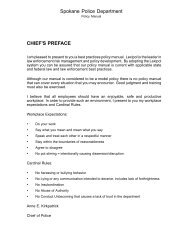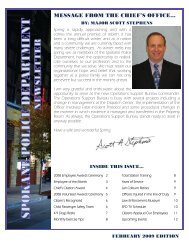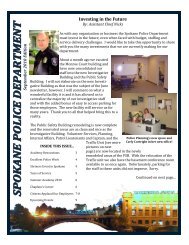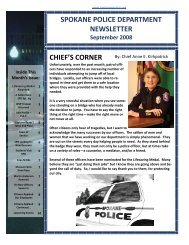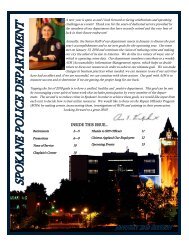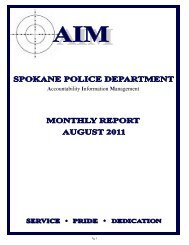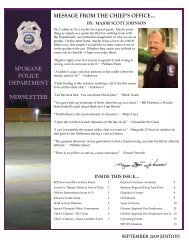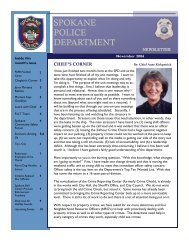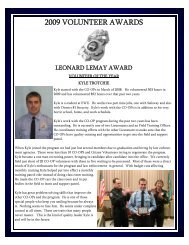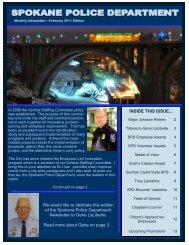DRAFT REPORT OF THE CITY OF SPOKANE USE ... - Samuel Walker
DRAFT REPORT OF THE CITY OF SPOKANE USE ... - Samuel Walker
DRAFT REPORT OF THE CITY OF SPOKANE USE ... - Samuel Walker
Create successful ePaper yourself
Turn your PDF publications into a flip-book with our unique Google optimized e-Paper software.
Mr. Earl F. Martin<br />
RE: <strong>REPORT</strong> TO <strong>USE</strong> <strong>OF</strong> FORCE COMMISSION<br />
December 3, 2012<br />
Page 15<br />
However, Det. Lesser agreed that high stress events can cause targeting concerns and<br />
training is necessary to address this issue. We discussed the concerns with regard to both multiple<br />
and long-term duration deployments and the need to do training to avoid excessive force issues when<br />
compliance with verbal commands is not achieved. Finally, the need for regular legal updates<br />
regarding proper ECD force options in this developing area of the law and the on-going concerns<br />
with regard to safety and warning issues was discussed. As a result, the benefits of regular<br />
in-service updates and re-certification with ECDs seemed to be apparent to Det. Lesser. Det. Lesser<br />
clearly understands the importance of training on these issues and agreed that regular updates on<br />
these areas of concern would be beneficial to SPD personnel. It is recommended that training such<br />
as this should be given greater emphasis and SPD training should include periodic blocks of training<br />
at briefing and regular in-service training which reinforce such concepts.<br />
The most recent training on ECDs conducted by Det. Lesser occurred on June 26, 2012 in<br />
the Pre-FTO training for the probationary officers. According to Det. Lesser, the training was<br />
conducted using the most recent version of TASER International information, Version 18.0. The<br />
probationary officers received a 4-hour block of instruction and each fired 3 cartridges from the<br />
TASER X26. Det. Lesser agreed that having officers receive 4-hours of training and firing 3<br />
cartridges does not constitute sufficient training for an officer for an indeterminate length of time and<br />
that regular periodic training that confirms proficiency with the device and re-familiarizes officers<br />
with the operation of a device seems prudent. Det. Lesser also sees the opportunity to incorporate<br />
ECD training in the Reality Based Training scenarios as a means of reaffirming the tactical, medical<br />
and legal considerations with regard to ECD deployments.<br />
We discussed the need to deal with maintenance of ECDs given feedback from field<br />
personnel that indicates they have concerns that the ECDs are not being maintained and that they<br />
have not functioned properly in the field on all occasions. Regular inspections and downloading<br />
of the ECDS is a recommended option. The benefits include not only confirming the devices are<br />
functioning properly, but also to sync up the internal time clocks of the devices. One option is for<br />
firearms instructors to be trained to check the ECDs and to download the devices and synchronize<br />
the internal clocks of the individual ECDs at firearms training sessions. If firearms instructors are<br />
not capable or willing to take on this responsibility, the alternative is to certify additional TASER<br />
instructors to handle this responsibility. Any M26 model ECDs that are currently in use should be<br />
replaced with the X26 promptly. Also, full deployment of ECDs should be confirmed in as much<br />
as this non-deadly force option has been proven to lower force levels used by officers, reduce injuries<br />
to arrestees and to officers in the field.



